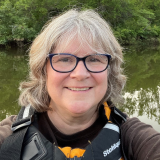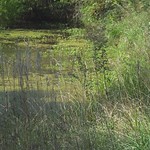Harmful Algal Bloom Video Challenge
See a Bloom, Give It Room: Urban Waters Edition

A harmful algal bloom (HAB) is an overgrowth of algae in a water body that can affect water quality and aquatic life. Some HABs can produce toxins that may also harm people, animals, and the local environment.
We want your help promoting public awareness of harmful algal blooms to people who use the waters, such as swimmers, boaters, fishers and people who bring pets to the water.
Learn more about harmful algal blooms.
On this page:
- 2021 Challenge Winners
- Challenge
- Rules
- Terms and Conditions
- How to Enter
- Prizes
- Judging
- Contact Information
- 2019 Challenge Winners
- Helpful Resources
2021 Challenge Winners

First Place: Kirby Hills of Kearney, Missouri, is the recipient of $6,000. His video, Fish Safety – Avoid Harmful Algal Blooms, explains the importance of staying safe by keeping plenty of distance from HABs. Hills grew up in Missouri and enjoys many outdoor activities, including fishing and kayaking around the Smithville Lake area. |

Second Place: LeAnn Hiserote of Kansas City, Missouri, is the recipient of $3,000. She is a preschool teacher, dog trainer, and dog owner who knows about the dangers HABs can have for our furry friends. Hiserote's video, Protect Your Pet from Harmful Algal Blooms, focuses on how to avoid those dangers. |

Third Place: Laura Hills of Kearney, Missouri, is the recipient of $2,000. She and her husband enjoy kayaking and boating near their home. Hills created a video to help to educate her community about the risks of HABs and hopefully keep them from getting sick. Her eerie video warns us all to Beware of Harmful Algal Blooms. |

EPA Region 7 created a special video featuring Regional Administrator Meg McCollister, in which she congratulates the 2021 HABs Video Challenge winners and gives an overview of the winning videos and harmful algal blooms. |
Challenge
Eligibility:
This challenge is open to any citizens over 18, companies, non-governmental organizations (NGOs), or educational institutions that are established residents or have a registered place of business in one of the following counties in the Kansas City, Missouri, metropolitan area: Bates, Caldwell, Cass, Clay, Clinton, Jackson, Lafayette, Platte or Ray.
Prizes:
EPA will select a grand prize winner who will receive $6,000. EPA will also select a second and third prize winner, who will receive $3,000 and $2,000 respectively.
Winning Entries:
In addition to cash prizes, winning videos will be posted on the EPA webpage and social media platforms. Winners will be announced in early 2022.
Judging Criteria:
Videos will be judged on scientific accuracy, creativity and quality.
Open Period:
The Challenge began on April 22, 2021. All video entries must be submitted in digital format by midnight CDT on Nov. 21, 2021 (extended deadline).
Submission Start:
April 22, 2021, at noon CDT
Submission End:
Nov. 21, 2021, at midnight CDT (extended deadline)
Rules
Video Content:
- Videos must focus on informing the public about harmful algal blooms in urban water bodies (e.g., neighborhood or community lakes or ponds and natural streams) and how to be safe around them. In the 0-2 minute video, Challenge-solvers must highlight at least one or more groups that use the waters, such as swimmers, boaters, fishers, or people who bring pets to the water.
- Videos should raise awareness about available local, state, or federal government resources for this issue. Applicants should strive to be creative, innovative and educational in their video content. Videos may include explanations or instructions.
- Identities of people, organizations, companies and institutions cannot appear in the video.
Video Specifications:
-
Be two minutes or less in length
- Source video file must be one of the following formats: MPEG4, 3GPP, MOV, AVI or WMV
- Aspect ratio of 16:9
- At either 24 or 30 (29.9) frames per second
- Frame size of 1920x1080
Selected winners will need to provide a video file to EPA.
Required Paperwork:
-
A written transcript of the video for closed-captioning purposes
- Video Challenge Entry Form
- License Agreement
- Consent Form (for each individual appearing on the video)
Required forms can be accessed in the Helpful Resources section below (see Documents).
Submission Limit:
Each entrant is limited to submitting one video in the Challenge. Multiple submissions from the same source will be disqualified.
Advisory for Challenge Participants:
As described further in materials linked to under Helpful Resources, harmful algal blooms pose a health risk to humans and animals. Stay a safe distance from the water when you suspect a harmful algal bloom is present. Do not touch or drink water with a bloom.
Helpful Resources:
To assist participants, EPA has assembled stock photos and video as well as other Helpful Resources in the section below.
Terms and Conditions
Eligibility:
- Any citizens over 18 that are established residents in one of the following counties in the Kansas City, Missouri, metropolitan area: Bates, Caldwell, Cass, Clay, Clinton, Jackson, Lafayette, Platte or Ray.
- Companies, non-governmental organizations (NGOs), or educational institutions with a registered place of business in one of the following counties in the Kansas City, Missouri metropolitan area: Bates, Caldwell, Cass, Clay, Clinton, Jackson, Lafayette, Platte or Ray.
- EPA and Missouri Department of Natural Resources employees and their family members may not apply.
Intellectual Property:
- Winning videos will be posted on the EPA webpage and announced in early 2022.
- Video content may be used by EPA and the general public for informational, educational, and or public relations purposes. Selected winners will need to provide a video file to EPA.
- All video entries must be accompanied with signed License Agreement and Consent Forms found below. Each individual appearing on the video must sign a Consent Form.
- Music use must follow EPA guidelines on music licensing. See the Helpful Resources section below.
- Challenge participants are responsible for complying with applicable copyright and intellectual property laws for any materials used in their videos. “Fair use” rules may allow the use of copyrighted material in certain circumstances. As an example, see the fair use guidelines on YouTube. Participants should seek legal guidance if they have questions about using copyrighted materials.
Non-Endorsement:
EPA and EPA officials do not endorse any product, service or enterprise that may appear in submitted videos. Furthermore, by recognizing winning videos, EPA is not endorsing products, services or enterprises that may appear in those videos.
Funding Restrictions:
- Challenge-solvers cannot use funding from the federal government (either through grants or contracts) to compete in the Challenge.
- All prize awards are subject to EPA verification of the winners’ identity, eligibility and participation in the Challenge. Awards will be paid using electronic funds transfer and may be subject to federal income taxes. EPA will comply with the International Revenue Service (IRS) withholding and reporting requirements, where applicable.
- A panel of EPA and Missouri Department of Natural Resources subject matter experts will judge video submissions. EPA will make final determinations and award all prize winners.
Plagiarism:
EPA has a no-tolerance policy for plagiarism. Any applicant whose winning work is determined to be plagiarized in whole or in part will forfeit any awards.
Assistance:
- Resources provided by EPA in the Helpful Resources section below may be used.
- Participants are responsible for all elements of the video including the research, writing, filming, graphics, and editing.
Waiver:
By entering this Challenge, participant agrees to assume any and all risks and waive claims against the federal government and its related entities (except in the case of willful misconduct) for any injury, death, damage, or loss of property, revenue, or profits, whether direct, indirect, or consequential, arising from their participation in the Challenge, whether the injury, death, damage, or loss arises through negligence or otherwise.
Disclaimer:
EPA reserves the right to disqualify and or clarify any submittal.
How to Enter
Entrants must post their video submission to YouTube as an unlisted video and send the link to their video entry, along with the required paperwork, by email to R7PublicAffairs@epa.gov by the deadline.
Submission URL:
Post video submission to YouTube as an unlisted video.
Submission Email:
- Send video link and required paperwork by email to R7PublicAffairs@epa.gov.
- Send emails with Subject: HAB Challenge Video Entry.
- Note: To ensure your submission is not blocked by EPA servers, please keep emails under 9 megabytes.
Prizes
Total Cash Prize Pool:
$11,000
Prize Breakdown:
- One grand prize winner will receive $6,000.
- One second prize winner will receive $3,000.
- One third prize winner will receive $2,000.
Non-Monetary Prizes:
No non-monetary prizes will be awarded.
Judging
Judging Panel:
Judges will be a panel of EPA and Missouri Department of Natural Resources subject matter experts. They will evaluate, score and rank submissions based on scientific accuracy, creativity and quality. They will make final determinations and award all prize winners.
Judging Criteria:
-
Has a clear message and theme that is easily understood (20 points)
- Is supported by scientific references on harmful algal blooms (20 points)
- Increases awareness of harmful algal bloom issues (15 points)
- Is educational, imparts knowledge, or deepens understanding of the issue by recreational users (15 points)
- Is in focus with balanced color and light and has logical transitions that move the narrative forward (10 points)
- Has discernable audio that is easily understood (10 points)
- Relates to a water body in in the Kansas City, Missouri, metropolitan area (10 points)
Contact Information
For questions about this challenge, please contact: R7PublicAffairs@epa.gov.
2019 Challenge
In 2019, EPA Regions 7 and 8 hosted a Harmful Algal Bloom Video Challenge for high school students. Entrants were asked to create videos that help people understand how to spot harmful algal blooms and how to be safe around them. Students were encouraged to be creative, have fun, and be a part of an environmental solution. A grand prize winner from each region, along with winners from each state and each region’s combined group of tribal nations, were selected. These winning videos were highlighted during EPA’s Harmful Algal Bloom Conference in February 2020 and will be used by EPA and state environmental agencies in public outreach initiatives.
The contest was open to the following EPA Region 7 and 8 areas:
- Region 7: Iowa, Kansas, Missouri, Nebraska, or one of nine tribal nations (listed here).
- Region 8: Montana, North Dakota, South Dakota, Wyoming, Utah, Colorado, or one of 27 tribal nations (listed here).
Grand Prize Winners |
|---|

|

|
Additional Award Winners
| Award | School | Students |
|---|---|---|
| Tribal First Place | Kickapoo Nation School |
Zaid Francisco
Vincente Dominguez
Trajan Wahwahsuck
|
| Nebraska First Place | Quest Forward Academy | Kinley Jackson |
| Kansas First Prize | Olathe High School |
Jenna Barnes
Lillian Campbell
|
| Tribal Runner-Up | Kickapoo Nation School |
Natasha Lewis
Catlin Gouge
|
| Iowa Runner-Up | Cedar Falls High School |
Olivia Combs
Colby Demyster
Allison Jermier
Trevor Fisher
Zachary McGuire
Talea Burt
|
| Colorado First Place | Montrose Peak Virtual Academy |
Ivan Green
Josephine Eccher
Reanna Troncose
Kelly Mathieu
|
| North Dakota Honorable Mention | Grand Forks Red River High School |
Melissa Ridley
Mark Mayor
Tina Preplow
|
Helpful Resources
Links:
Images:

Visit NOAA's Great Lakes Environmental Laboratory photostream on Flickr
Video:







